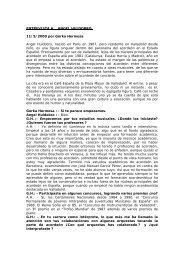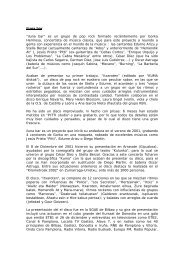The Accordion in the 19th Century - Gorka Hermosa
The Accordion in the 19th Century - Gorka Hermosa
The Accordion in the 19th Century - Gorka Hermosa
Create successful ePaper yourself
Turn your PDF publications into a flip-book with our unique Google optimized e-Paper software.
several of his pa<strong>in</strong>t<strong>in</strong>gs: Acordeonista y niños (1903), Estudio de un clown con<br />
acordeón (1905), Saltimbanquis: danza al son del acordeón (1905), El acordeonista<br />
(1911), Acordeonista (hombre con sombrero) (1916) and Mar<strong>in</strong>ero tocando el acordeón<br />
(1912). [120, 121, 122, 123, 124]<br />
Fig. 100: Joaquín Tur<strong>in</strong>a Fig. 101: Acordeonista Fig. 102: El acordeonista 192<br />
(c. 1888) 193 . y niños 194 (Picasso, 1903) (Picasso, 1911)<br />
In Catalonia, <strong>the</strong> first reference to <strong>the</strong> accordion is from 1841 [338]. In Barcelona<br />
<strong>in</strong> 1889, <strong>the</strong>re were some documented concerts performed by Mr. Costa, Manuel Peretó,<br />
Ms. Arqué, Ernesto Fernández and <strong>the</strong> accordion quartet Autoville. [58, 226]<br />
In Basque Country, <strong>the</strong> first documented appearances of accordionists were Jean<br />
Baptiste Busca (1839-1902) <strong>in</strong> 1859 195 at Goiherri valley [1] and D.F. Erezuma <strong>in</strong> Bilbao<br />
<strong>in</strong> 1860 [226]. Mr. Santisteban ga<strong>in</strong>ed noteworthy reputation <strong>in</strong> San Sebastián, he even<br />
played to close out a ceremonial mass <strong>in</strong> Zubieta <strong>in</strong> 1877 for <strong>the</strong> most important<br />
authorities <strong>in</strong> <strong>the</strong> prov<strong>in</strong>ce <strong>in</strong>terpret<strong>in</strong>g <strong>the</strong> Basque an<strong>the</strong>m of <strong>the</strong> time: Gernikako<br />
Arbola by José María Iparraguirre (1820-1881) [342]. <strong>The</strong> first<br />
reference to <strong>the</strong> accordion at a popular festival is from 1889.<br />
This was <strong>the</strong> entrance of <strong>the</strong> accordion <strong>in</strong> <strong>the</strong> trikitixa, or<br />
traditional tunes that were orig<strong>in</strong>ally meant for enterta<strong>in</strong>ment<br />
at popular festivals, whose ma<strong>in</strong> element was <strong>the</strong><br />
accompaniment of <strong>the</strong> tambour<strong>in</strong>e which, until <strong>the</strong> arrival of<br />
<strong>the</strong> accordion, would be used to accompany <strong>the</strong> vocals, <strong>the</strong><br />
txistu 196 or <strong>the</strong> alboka 197 . S<strong>in</strong>ce <strong>the</strong>n, <strong>the</strong> duo of diatonic<br />
accordion and tambour<strong>in</strong>e has been <strong>the</strong> characteristic<br />
ensemble of this music. It comprises <strong>in</strong>strumental rhythms<br />
like <strong>the</strong> ariñ-ariñ, <strong>the</strong> fandango or <strong>the</strong> biribilketa and sung<br />
rhythms like <strong>the</strong> porrusalda or <strong>the</strong> trikitixa 198 . [1, 7, 8, 12, 36, 101,<br />
110, 128, 130, 139, 223,<br />
224, 225, 227, 234, 286, 290, 322, 362, 364, 364, 377, 393, 411] Fig. 103: Manuel Baquero y Lezaun 199<br />
192<br />
Fig. taken from: http://www.wildsound-filmmak<strong>in</strong>g-feedback-events.com/book_of_possibilities.html<br />
193<br />
Fig. taken from: http://www.islabahia.com/arenaycal/1999/06junio/musica.htm<br />
194<br />
Fig. taken from: http://www.pa<strong>in</strong>t<strong>in</strong>g-palace.com/en/pa<strong>in</strong>t<strong>in</strong>gs/28534<br />
195<br />
Italian who went to work <strong>in</strong> <strong>the</strong> area of Goiherri <strong>in</strong> 1859 and decided to live <strong>the</strong>re. [1]<br />
196<br />
Basque flute with 3 holes. [343]<br />
197<br />
Beat<strong>in</strong>g double reed <strong>in</strong>strument. [291]<br />
198<br />
<strong>The</strong> word trikitixa (or trikitrixa accord<strong>in</strong>g to o<strong>the</strong>r authors like Javier Ramos) has three possible mean<strong>in</strong>gs: <strong>the</strong> music style we are<br />
referr<strong>in</strong>g, <strong>the</strong> vocal sub-genre of this music style and, although not a properly correct denom<strong>in</strong>ation, it is also used to refer to <strong>the</strong><br />
specific model of diatonic accordion normally used to perform this music.<br />
199<br />
Fig. taken from: Baquero [21] page 1.<br />
44




